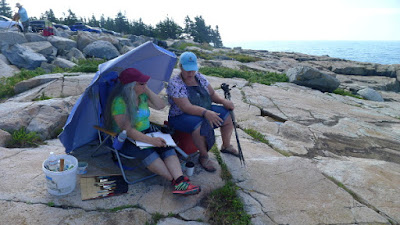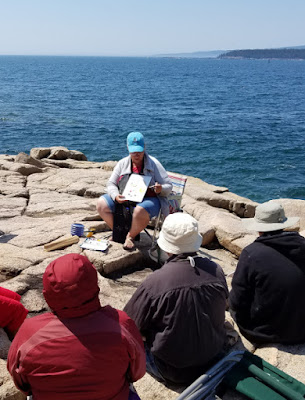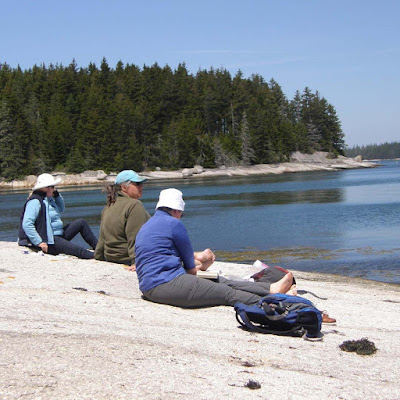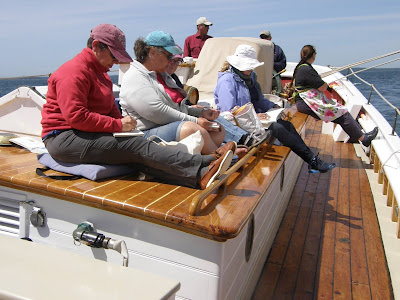How do you get to Carnegie Hall? Practice, practice, practice!
 |
| Watercoloring at Schoodic Point with Rebecca Bense. |
Sometimes, the people who struggle in painting class are the ones you’d least expect to have trouble. They’re accomplished in their professional life, and they’ve demonstrated the capacity to master complex subjects quickly.
That proficiency can be their undoing. When they don’t immediately understand the process, they’re flummoxed. Understand ideas helps, but it’s not everything. They have to learn another way of learning—grasping an idea from the hands, not the head.
The critic may understand all the elements that make a good painting, but it’s unlikely that he or she can paint or draw anything. The working artist may understand none of those things, but is still able to make enchanting paintings. It’s all about where they’ve concentrated their effort.
 |
| It’s not all about what the teacher says; it’s mostly about what you do with that information. |
You’ll do better in a workshop or class if you aim to enjoy the process, rather than focus on the end result. You can’t expect perfection in a week. The more time you spend working on art, the better you’ll be.
In my classes, I concentrate on one aspect of painting each session. I’m limiting the scope of the project. Painting involves so many complex skills and techniques that if they were all thrown at us at once, we’d be overwhelmed. If you’re teaching yourself, you need to find ways to limit scope on your own. Choose one or two things that you want to improve—such as your color handling or mark-making—and concentrate on just those until you’ve made them better. Then move on to the next thing.
 |
| Painting buddies on Penobscot Bay. |
A painting buddy is a great asset, as a coach, a sounding board, and for moral support. I love the interactions in my classes, because they’re uniformly positive. In most cases, people really do wish their friends the best.
Gaye Adamshas some shrewd advice about practice: “It is important to lock in the learning. Recognize that workshops shorten the learning curve, which is awesome, but they are not a substitute for easel time.”
It’s difficult to paint for a short time every day, because of the set up and clean up. However, you can always carry a sketchbook and draw. Drawing is the single best thing you can do to improve your painting, and it’s fun. Save the painting for those periods when you have a few hours of uninterrupted time.
 |
| Painting aboard American Eagle last summer. |
Sometimes we need more support than can be offered by practice alone. In that case, a teacher is very helpful. Check out their class size, the work being done by their students, and—above all—if they’re painting in a style that pleases you.
My own August workshop at Schoodic Institute in Acadia National Park is sold out. However, there are still a few openings in my sketch-watercolor workshop aboard the schooner American Eagle, June 9-13, 2019. This is a class to learn how to catch landscape quickly and expressively in watercolor, pen and pencil. Materials are provided. For more information, see here, or email me for more information.
